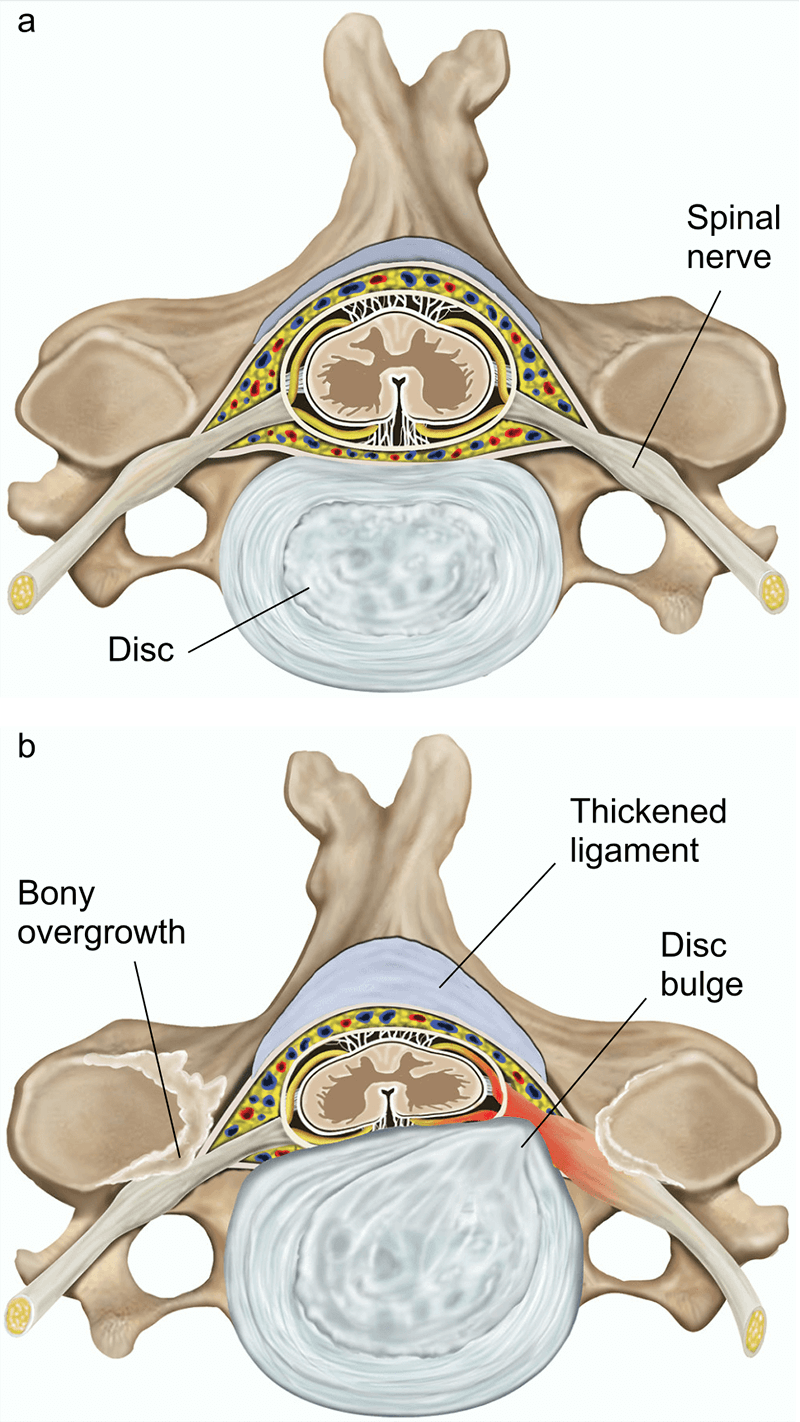Cervical laminectomy
What is cervical spinal stenosis?
Cervical spinal stenosis is where the spinal canal narrows in your neck.
The spinal cord passes down the spinal canal from your brain. Nerves from your spinal cord and blood vessels that supply the nerves pass into the spinal canal within the vertebrae.
The spinal canal tends to narrow as we get older caused by bony overgrowth from wear and tear in the facet joints, thickening of surrounding ligaments and bulging of the discs. A narrowed spinal canal in your neck can press on your spinal cord, preventing it from working properly.

b) A disc bulge pressing on a spinal nerve
What are the benefits of surgery?
The aim is to prevent further damage to your spinal cord. Surgery cannot repair damage to your spinal cord but your symptoms may improve.
Are there any alternatives to surgery?
If your symptoms are mild, you may not need any treatment. If your symptoms are severe or are getting worse, surgery is usually the only option.
What does the operation involve?
The operation is usually performed under a general anaesthetic but various anaesthetic techniques are possible. The operation usually takes 1 to 2 hours.
Your surgeon will make a cut on the centre of the back of your neck. They will part the muscles to get to your spine.
Your surgeon will remove enough bone and ligament tissue to open up the narrowed part of the canal, giving the spinal cord and blood vessels more room.
What complications can happen?
Some complications can be serious and can even cause death.
General complications of any operation
- bleeding
- infection of the surgical site (wound)
- allergic reaction to the equipment, materials or medication
- difficulty passing urine
- Venous thromboembolism (VTE)
- chest infection
- heart attack or stroke
Specific complications of this operation
- neuropathic pain. This is a burning pain that may happen once the pressure on the nerves has been released
- injury to your spinal cord and nerves
- infection in your spine
- damage to the nerve roots
- tear of the thin membrane that covers the nerves in your spine
- spinal instability
Consequences of this procedure
- pain
- unsightly scarring
How soon will I recover?
Keep your wound dry for 10 days.
You should be able to go home after 2 to 3 days.
Do not lift anything heavy or twist your body. Make sure you keep a good posture when sitting and walking.
Regular exercise should help you to return to normal activities as soon as possible. Before you start exercising, ask the healthcare team or your GP for advice.
Speak to the healthcare team about any vaccinations you might need to reduce your risk of serious illness while you recover. When you come into hospital, practise hand washing and wear a face covering when asked.
Most people make a good recovery from surgery.
Summary
Cervical spinal stenosis is where the spinal canal narrows in your neck, causing weakness or numbness in your arms and legs. The aim of surgery is to prevent further damage to your spinal cord.
IMPORTANT INFORMATION
The operation and treatment information on this page is published under license by Healthdirect Australia from EIDO Healthcare Australia and is protected by copyright laws. Other than for your personal, non-commercial use, you may not copy, print out, download or otherwise reproduce any of the information. The information should not replace advice that your relevant health professional would give you. Medical Illustration Copyright © Medical-Artist.com.
For more on how this information was prepared, click here.
Learn more here about the development and quality assurance of healthdirect content.
Last reviewed: September 2024










